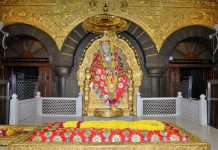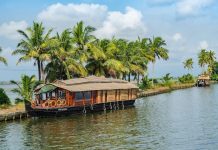The historic town of Vaishali in Bihar, that has been mentioned in mythological texts such as the Mahabharata, is also a place that’s surrounded by dense mango and banana groves as well as extensive rice fields. From a Buddhist monastery that is found at the edge of the city, to many other religious and historical places, here’s what you must explore on a trip here.
Ashokan Pillar
Erected by Emperor Ashoka, the Ashokan Pillar at Vaishali holds great significance for Buddhists. As a historical monument, it attracts a lot of travellers who’re keenly interested in archaeology. Unlike other Ashokan Pillars, this one does not bear inscriptions by King Ashoka.
Vishwa Shanti Stupa
Erected by Nipponzan Myhoji following the teachings of Saodharma Pundarika Sutra, the Vishwa Shanti Stupa was built as a symbol of peace and tranquility. There are artefacts across the structure that pay homage to Lord Buddha.
Raja Vishal ka Garh
Also known as the ancient parliament house, Raja Vishal ka Garh is an interesting dome spanning about a kilometre, with walls about two metres high. A moat surrounds the corner of the tower, and served as a building of importance during King Vishal’s rule.
Kundalpur
A historic location very close to Vaishali, Kundalpur is popular also as a pilgrimage site for Jains and houses the statue of Baba Adinath. It is also believed to be the birthplace of Lord Mahavir, who is said to have spent about two decades of his life in Vaishali.
Ramchaura Mandir
Situated in Hajipura, a city close to Vaishali, the temple is dedicated to Lord Ram and is said to have been around since the time of Ramayana. The temple especially attracts hordes of people during the occasion of Ram Navami. It is believed that Lord Ram spent some time here after which it gained popularity as a pilgrim spot.
5 Quick Monsoon Getaways From Chennai
Chennai is surrounded by tons of places one can visit for a quick weekend getaway. Now that the monsoons are in full swing, the hilly stations, especially, look resplendent after the showers of rain. Give the city life a break and head to these places for some quiet time amidst nature.
Yercaud
If there’s one hill station you have to choose for a quick getaway, let it be Yercaud. It is the perfect place for all the travellers seeking respite from the city heat. Nestled in Shevaroy Hills, Yecaud is tremendously gorgeous and a treat to the eyes. If you just want to relax and unwind, book yourself a resort that overlooks the spectacular views of nature. Also great for trekking and wildlife watching, the most commonly spotted animals here are fox, squirrel, deer, snake and birds.
Coonoor
Located in the Nilgiri district, Coonoor is mostly known for its Nilgiri tea production. Perched at an elevation of 1,850 meters, Coonoor offers unadulterated serenity, solitude, lush greenery and adventurous trekking trails. The major attractions here include Droog Fort offering a sweeping panoramic view of Coonoor and the cascading Laws Falls.
Horsley Hills
This one’s a delightful hilly retreat; the majestic hills, wispy clouds and verdant greenery make it look like it’s straight out of a painting. Horsley Hills are a group of several hills and was named after a British collector. Situated in Andhra Pradesh, the unspoiled environs of Horsley Hills along with attractions such as Gangotri Lake, Horsley Museum and the Environmental Park, make your visit an enchanting experience. There’s also scope for activities like zorbing here.
Yelagiri
A favourite among trekkers, Yelagiri is a quaint and charming hill station located at an altitude of 4,626 feet above sea level. The highlight of this place are its picturesque landscapes, stunning green valleys and the vibrant rose gardens and orchards. Other adventure activities you can indulge in are rock-climbing and paragliding.
Meghamalai
Dotted with cardamom plantations and tea estates, this mountain range in the Western Ghats is a sight to behold. Situated 1,500 metres above sea level, and rich and exotic flora and fauna, a quick trip here is highly rejuvenating. One of the must-do things here is to catch a sunset from the banks of the lake. There’s even a wildlife sanctuary here where you can spot animals like the great pied hornbill, Indian brown mongoose, Jerdon’s palm civet, white-bellied short-wing, black-naped monarch, gaur, tiger, leopard, Asian elephant and mouse deer.
Marayur: Of Sandalwood Forests And Rock Paintings
Located 169km from Kochi, Marayur (or Marayoor) is a quaint village in the Idduki district of Kerala. Nestled in the Western Ghats, it is a nature lover’s paradise. It is widely believed that Marayur dates back to the Stone Age civilisation, and is a great place to visit if you are looking for a quick getaway from the bustle of everyday life.
Interestingy, Marayur is the only place in Kerala where sandalwood trees grow naturally. If you have to take something back from here, make sure it’s the authentic sandalwood oil produced in Marayur. Home to over 1,000 species of flowering plants and many medicinal plants, the forests of Marayur are also home to the endangered grizzled giant squirrel.
If you’re a wildlife aficionado, the Chinnar Wildlife Sanctuary is a must-visit. With over 225 species of birds and a variety of reptiles including the mugger crocodile, other commonly spotted animals are the white bison, langur, gaur, leopard, tiger and elephant. Especially during the monsoons, the sanctuary is also home to a large number of beautiful butterflies.
Other attractions in the town include the ‘dolmens’ or burial chambers. Also known as the muniyaras and built during the Iron Age, these structures were made by placing four stones on the edge and the fifth one on top as cover. You will spot several of these located around Thenkasinathan Temple, built by the banks of Pambar river.
Another attraction you must not miss is the Ezhuthu Guha located at Attala. It is a hub of interesting rock paintings, and about 90 of these motifs still exist. Most of these painted motifs are abstract in design; there are also a few in animal and human figures. It’s the most popular rock art site in Kerala, however, unruly tourism has resulted in vandalism of a lot of these rock paintings.
Gaya: The Land Of Temples And Monasteries
One of India’s holiest cities, Gaya is a centre for various faiths and beliefs including Hinduism, Jainism and Buddhism. Dotted with ancient temples and monasteries, the structures are testimony to the architectural brilliance of its past. For nature lovers too, Gaya is the perfect setting amidst hills, presenting a picturesque landscape that is calming and rejuvenating.
Vishnupad Temple
Located on the banks of Falgu river, the 18th-century temple is said to be constructed on Lord Vishnu’s footprints. However, the huge temple complex also displays images of various other Gods and Goddesses. There’s even a temple dedicated to Lord Narasimha in the courtyard of the Vishnupad Temple.
Bodhi Tree
Bodhi Tree is where Gautam Buddha had attained spiritual enlightenment. Located on the southern side of Mahabodhi Temple, the tree however is believed to have been grown from a sapling of the original tree in 620 AD. Legend goes that, the Bodhi Tree was destroyed many times; once by Emperor Ashoka’s wife and later by King Sesaka.
Chinese Temple And Monastery
Located near the Mahabodhi Temple, the Chinese Temple was built by the government and the Buddhist monks of China in 1945. The 200-year-old Buddha statue found inside is said to be from China, along with three other golden statues of Buddha. Built in traditional Chinese architectural style, it’s quite a wonder to the eye.
Bodhgaya Archaeological Museum
Established in the 1950s, Bodhgaya Archaeological Museum houses several relics that were unearthed in Gaya. The collections include rare sculptures belonging to the 1st-century BC, antiques of Hindu deities and Buddha made of various metals including gold, bronze and silver.
Royal Bhutan Monastery
Known for its wonderful depiction of the life of Buddha, this monastery was built by the King of Bhutan and ranks amongst the most majestic monasteries in the country. It also houses a beautiful temple with a 7 feet tall Buddha statue inside. The serene atmosphere in the monastery makes it a wonderful place to meditate.
Top 5 Must-Visit Lakes of Northeast India
It’s no surprise that one of the most beautiful parts of India is the northeast comprising of states like Manipur, Assam, Nagaland, and Arunachal Pradesh among others. The natural beauty found in these places are surreal and absolutely breath-taking. While there’s everything from mountains to waterfalls, it’s the gleaming blue lakes here that top our list.
Chandubi Lake, Assam
Located 64 kilometres from Guwahati at the foot of Garo Hills, this lake is surrounded by part Assam and part Meghalaya. It’s a bird-watcher’s paradise; especially during winters when it attracts migratory birds in large numbers. Also, since the lake is surrounded by deep forests and tea gardens, it lends an ethereal beauty to the landscape.
Loktak Lake, Manipur
The largest freshwater lake of the northeast, Loktak Lake is about some 53km away from Imphal in Manipur. The highlight of this lake is Keibul Lamjao National Park – the only floating national park in the world. Home to endangered species like Sangai (Nagaland’s state animal) also known as brow-antlered deer, other commonly spotted animals here include fox, common otter and wild boar.
Gurudongmar Lake, Sikkim
Perched at 17,800 feet above sea level, Gurudongmar Lake is one of the highest altitude lakes in the world. Since it’s located in the north of Sikkim, it mostly remains frozen for most part of the year. About 174km from Gangtok, the drive to this glacier-fed, glittering lake is definitely worth the effort.
Shilloi Lake, Nagaland
Shaped in the form of a human foot, Shilloi Lake isn’t used for fishing, drinking or irrigation by the locals due to some mythological belief. It’s one of the cleanest and most serene places to explore in Nagaland. If you’re a birder, migratory birds, especially the Siberian cranes, are often spotted around this lake.
Sangetsar Lake, Arunachal Pradesh
Another beautiful high-altitude lake, at 12,000 feet above sea level, and about 30km from Tawang, this lake got popular after the Bollywood movie Koyla was shot here. Interestingly, this lake doesn’t dry in the hottest of weather and neither does it freeze in the coldest temperature.
What to See And do in The Quaint Village of Tuophema
About 45km north of Kohima, while the ascent to Tuophema is only one and a half hours long, it has a completely new world of its own. It’s an absolutely simple rustic village, without any sign of modernisation. Yet, that is what makes it so special to the avid traveller.
This is where members of the Angami tribe reside; if you want a taste of the Naga culture, Tuophema should feature on top of your list. It’s one thing to see the Naga tribes put their best foot forward at the various festivals such as the Hornbill Festival and Sekrenyi Festival, and a completely different experience to get up close and personal with the daily workings of their lives.
Tuophema was essentially set up as a tourist village in 2001. Self-funded and designed by the people of Tuophema as well as the different clans from within the village, it is now hailed as a model of rural home-stays in Nagaland.
A traditional welcome gate leads up to the village, where a large tree called the War Head Tree is quite the eye-catcher. It’s where enemy heads were once hung as trophies from the war. It’s highly recommended that you stay in a traditional Angami house; there are some 500 families living in the quaint town and it’s a treat to see everyone know each other.
Other things to do and see here include cultural and educational programmes, a local museum, as well as guided walks arranged by the helpful staff at the village. The walk takes you past the old and new areas of the village, including the Baptist church, an amphitheatre, and a charming unoccupied house built in the memory of the village founder.
For one of the most unforgettable experience in Tuophema, sit out under the night sky with hundreds and thousands of stars twinkling above you, a warm drink in hand and your loved ones huddled close by.




